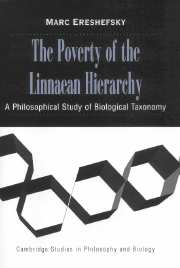6 - The Evolution of the Linnaean Hierarchy
Published online by Cambridge University Press: 16 July 2009
Summary
Throughout this book we have looked at issues framed in terms of the Linnaean hierarchy. Does membership in a species depend on the qualitative properties of its organisms or the causal relations among them? What distinguishes species taxa from such higher taxa as genera, families, and orders? Should we adopt monism or pluralism when it comes to the species category? Thus far we have taken the Linnaean system for granted. But should we?
Before addressing that question, it should be noted that the Linnaean system of classification is much more than a hierarchy of taxonomic ranks. Linnaeus also provided rules for sorting organisms into taxa, as well as rules for naming taxa. These features of the Linnaean system were premised on Linnaeus's biological theory, in particular, his assumptions of creationism and essentialism. Needless to say, these assumptions have gone by the wayside in biology and have been replaced by evolutionary theory. Still, the vast majority of biologists use the Linnaean hierarchy and its system of nomenclature. On the face of it, this may seem odd: biologists employ a system of classification whose theoretical basis has become obsolete. The continued use of the Linnaean system is more problematic when one considers that the system has lost its sorting rules, that cladistic revisions to the system render it less and less Linnaean, and that what remains of the system is flawed on pragmatic grounds.
Information
- Type
- Chapter
- Information
- The Poverty of the Linnaean HierarchyA Philosophical Study of Biological Taxonomy, pp. 199 - 237Publisher: Cambridge University PressPrint publication year: 2000
